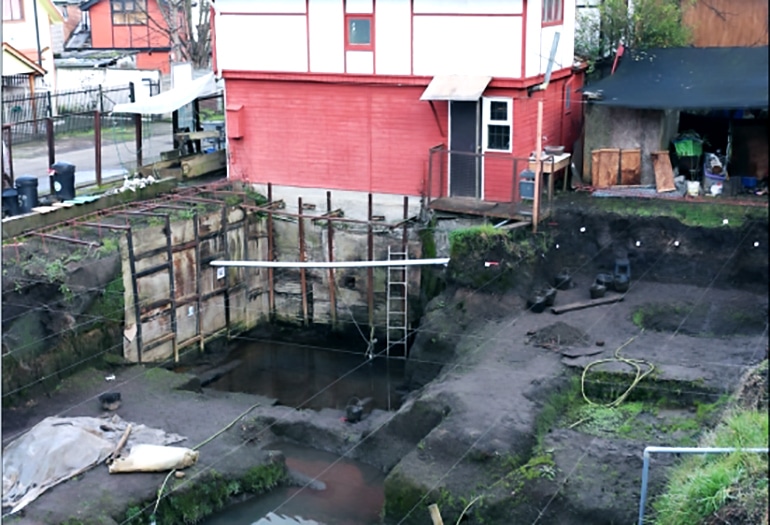Researchers have discovered new evidence to support the Younger Dryas Impact Hypothesis, which postulates that a fragmented comet slammed into the Earth close to 12,800 years ago.
When James Kennett and his colleagues set out years ago to examine signs of a major cosmic impact toward the end of the Pleistocene epoch, little did they know just how far-reaching the projected climatic effect would be.
“It’s much more extreme than I ever thought when I started this work,” notes Kennett, a professor of geology at the University of California, Santa Barbara. “The more work that has been done, the more extreme it seems.”
The hypothesis maintains that the impact caused rapid climatic changes, megafaunal extinctions, sudden human population decrease and cultural shifts, and widespread wildfires (biomass burning). The hypothesis suggests a possible triggering mechanism for the abrupt changes in climate at that time, in particular a rapid cooling in the Northern Hemisphere, called the Younger Dryas, amid a general global trend of natural warming and ice sheet melting that show changes in the fossil and sediment record.

Controversial from the time scientists proposed it, those who prefer to attribute the end-Pleistocene reversal in warming entirely to terrestrial causes continue to contest the hypothesis even now. But Kennett and fellow stalwarts of the Younger Dryas Boundary (YDB) Impact Hypothesis, as it is also known, have recently received a major boost: the discovery of a very young, 31-kilometer-wide (19-mile-wide) impact crater beneath the Greenland ice sheet, which they believe may have been one of the many comet fragments that struck Earth at the onset of the Younger Dryas.
Now, in a paper in the journal Nature Scientific Reports, the researchers present further evidence of a cosmic impact, this time far south of the equator, that likely led to biomass burning, climate change, and megafaunal extinctions nearly 13,000 years ago.
‘A major expansion’
“We have identified the YDB layer at high latitudes in the Southern Hemisphere at near 41 degrees south, close to the tip of South America,” Kennett says. This is a major expansion of the extent of the YDB event.” The vast majority of evidence to date, he adds, has been found in the Northern Hemisphere.
This discovery began several years ago, according to Kennett, when a group of Chilean scientists studying sediment layers at a well-known Quaternary paleontological and archaeological site, Pilauco Bajo, recognized changes known to be associated with YDB impact event. They included a “black mat” layer, 12,800 years in age, that coincided with the disappearance of South American Pleistocene megafauna fossils, an abrupt shift in regional vegetation and a disappearance of human artifacts.
“Because the sequencing of these events looked like what had already been described in the YDB papers for North America and Western Europe, the group decided to run analyses of impact-related proxies in search of the YDB layer,” Kennett says. This yielded the presence of microscopic spherules that researchers interpreted as forming by melting due to the extremely high temperatures associated with impact. The layer containing these spherules also show peak concentrations of platinum and gold, and native iron particles rarely found in nature.
“Among the most important spherules are those that are chromium-rich,” Kennett explains. The Pilauco site spherules contain an unusual level of chromium, an element from South America, not in Northern Hemisphere YDB impact spherules.
“It turns out that volcanic rocks in the southern Andes can be rich in chromium, and these rocks provided a local source for this chromium,” he adds. “Thus, the cometary objects must have hit South America as well.”
Other evidence, which, Kennett notes, is consistent with previous and ongoing documentation of the region by Chilean scientists, pointed to a “very large environmental disruption at about 40 degrees south.” These included a large biomass burning event that, among other things, micro-charcoal and signs of burning in pollen samples researchers collected at the impact layer shown.
“It’s by far the biggest burn event in this region we see in the record that spans thousands of years,” Kennett says. Furthermore, he continues, the burning coincides with the timing of major YDB-related burning events in North America and western Europe.
Climate shifts
The sedimentary layers at Pilauco contain a valuable record of pollen and seeds that show change in character of regional vegetation—evidence of a shifting climate. However, in contrast to the Northern Hemisphere, where conditions became colder and wetter at the onset of the Younger Dryas, the opposite occurred in the Southern Hemisphere.
“The plant assemblages indicate that there was an abrupt and major shift in the vegetation from wet, cold conditions at Pilauco to warm, dry conditions,” Kennett says.
According to Kennett, the atmospheric zonal climatic belts shifted “like a seesaw,” with a synergistic mechanism, bringing warming to the Southern Hemisphere even as the Northern Hemisphere experienced cooling and expanding sea ice. The rapidity—within a few years—with which the climate shifted is best attributed to impact-related shifts in atmospheric systems, rather than to the slower oceanic processes, Kennett says.
Meanwhile, the impact with its associated major environmental effects, including burning, is thought to have contributed to the extinction of local South American Pleistocene megafauna—including giant ground sloths, sabretooth cats, mammoths, and elephant-like gomphotheres—as well as the termination of the culture similar to the Clovis culture in the north, he adds. The amount of bones, artifacts, and megafauna-associated fungi that were relatively abundant in the soil at the Pilauco site declined precipitously at the impact layer, indicating a major local disruption.
The distance of this recently identified YDB site—about 6,000 kilometers (around 3728 miles) from the closest well-studied site in South America—and its correlation with the many Northern Hemispheric sites “greatly expands the extent of the YDB impact event,” Kennett says.
The sedimentary and paleo-vegetative evidence researchers gathered at the Pilauco site is in line with previous, separate studies Chilean scientists conducted that indicate a widespread burn and sudden major climate shifts in the region at about YDB onset. This new study further bolsters the hypothesis that a cosmic impact triggered the atmospheric and oceanic conditions of the Younger Dryas, he says.
“This is further evidence that the Younger Dryas climatic onset is an extreme global event, with major consequences on the animal life and the human life at the time,” Kennett says. “And this Pilauco section is consistent with that.”
Additional researchers contributing to the work came from Universidad Austral de Chile, Universidad Católica de Temuco, Elizabeth City State University, University of South Carolina, Northern Arizona University, DePaul University, Comet Research Group.
Source: UC Santa Barbara


